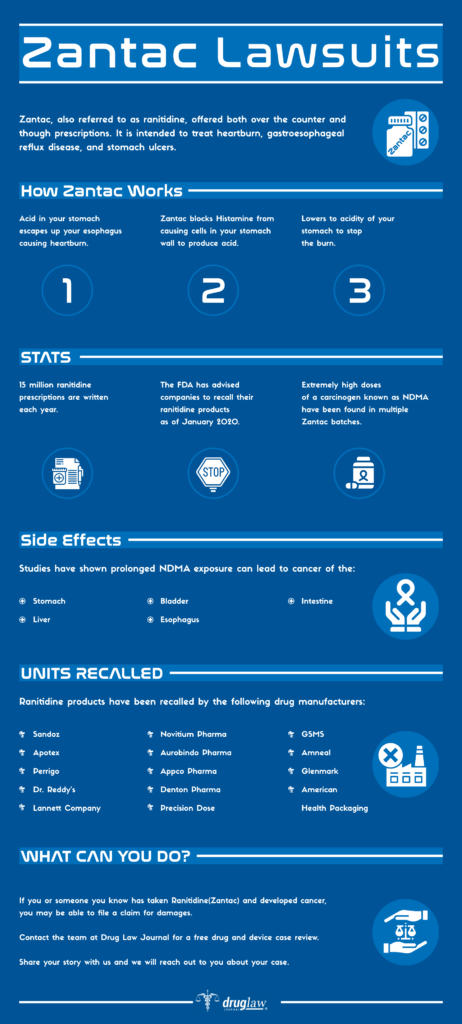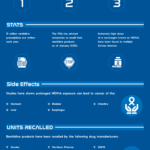Zantac is the well-known brand name for an oral medication that has been used to treat and prevent conditions affiliated with the excess production of stomach acid, such as: heartburn, ulcers and common inflammations of the esophagus like Gastro-Esophageal Reflux Disease (GERD). Part of a family of drugs known as H2-blockers, Zantac was, until recently, available both as an over-the-counter (OTC) and prescription medication. In September 2019, the Food and Drug Administration (FDA) issued a statement alerting the public and physicians that Zantac and some of its generic equivalents contained a probable carcinogen. This statement was followed up on April 1, 2020, with a request from the FDA that manufacturers withdraw Zantac and generic equivalents from store shelves completely.
Prescription Name and Overview
Zantac is the product name for the drug ranitidine. It was available both in prescription form as well as OTC and is generally consumed in oral dosages for the treatment and relief of ulcers in the stomach and intestines, as well as esophageal and somach ailments. It is part of a family or class of drugs like Tagamet (cimeltadine), Axid (nizatidine) and Pepcid (famotidine) which are known as “H2-Blockers” for their method of action in blocking the action of histamine in cells in the stomach. Although Zantac was one of the best-selling drugs in history and a huge source of prestige and revenue for its manufacturer, GlaxoSmithKline (in the United Kingdom) and Sanofi (in the United States), profits from sales of Zantac and its generic equivalents took a massive hit in 2019 when the FDA issued a warning concerning the presence of N-nitrosodimethlamine (NDMA), a probable human carcinogen in laboratory settings. The FDA warning was amplified in April 2020 with a total recall of all prescription and OTC ranitidine products from the U.S. market pursuant to its ongoing investigation over the presence of NDMA contaimination of Zantac and some of its generic equivalents.
Generic Name and Overview
Therapeutic equivalents are/were marketed under the drug name Ranitidine.
OTC Name and Overview
Manufacturer
Zantac (ranitidine)
Sanofi, S.A./Sanofi-U.S. (United States)
Labeled Indications
FDA-approved uses include the treatment of duodenal and gastic ulcers, GERD, and erosive esphagitis which have been diagnosed through endscopy. Zantac is also approved for the treatment of Zoellinger-Ellison syndrome, which causes excess production of stomach acid. Zantac was determined suitable for both short-term and long-term use dependent upon dosage.
Dosages
Active Duodenal Ulcer
150mg Twice Dailiy or 300mg Once Daily After Evening Meal
Zollinger-Ellison Syndrome and Other Pathalogical Hypersecretory Conditions
150mg Twice Daily
Benign Gastic Ulcer
150mg Twice Daily
GERD
150mg Twice Daily
Erosive Esophagitis
150mg Four Times Daily
What Is It Used For?
Zantac is usd to trreat ulcers all along the intestinal tract and then prevent their return following treatment and healing. In its OTC form Zantac is commonly used to treat heartburn and related symtpoms stemming from too much acid production in the stomach.
How Does it Work?
Zantac belongs to a family of drugs which are referred to as “H2-Blockers”or “histamine receptor antagonists”. Histamine is a naturally occuring chemical in the human body that acts upon receptors in the cells of the stomach which triggers the production of stomach acid during the process of digestion. It works to block H2 receptors in the cells lining the stomach, and causes them to produce less stomach acid. Zantac also helps to relieve pressue and symptoms from indigestion caused by excess stomach acid and reduces backflow of acid into the esophagus. Finally, the H2 blocking action allows peptic ulcers time to heal by reducing the amount of acid in the stomach and duodenum.
What are the Approved Uses?
It is approved for treating and preventing ulcers in the duodenum and stomach. It is also used for treating heartburn, erosive esophagitis and Zoeller-Ellison syndrome.
Production Anecdotes / History
First approved by the FDA in 1984, Zantac was the second H2-Blocker approved for the U.S. market. Upon approval, it began a decades-long climb to dominate the market for ulcer, heartburn and acid indigestion treatments which made it one of the best selling drugs in history. Zantac was initially developed by GlaxoSmithKline (GSK) to match the success of another H2-Blocker, Tagamet. Through a well-documented approach modifying existing drug technology, GSK was able to fashion Zantac as a Tagamet alternative with improved tolerability, longer lasting action and fewer issues with intolerance. Since reaching its peak in market-share in 1988, Zantac has since been largely superceded by the introduction of Proton Pump Inhibitors (PPIs), such as Priolesc (omeprazole), into the marketplace.
In September 2019, the FDA first announced that Zantac and some of its generic equivalents had been found to be contaminated with NDMA, a probable human carcinogen. At the same time, regulators in Canada announced that companies there would cease marketing Zantac and its generic equivalents until evidence surfaces that its level of NDMA contamination is not unacceptable. Other manufacturers of generic equivalents in the U.S. followed suit with voluntary recalls of their products and on April 1, 2020, the FDA announed a mandatory withdrawal of prescription and OTC Zantac and generic equivalents from store and pharmacy shelves throughout the United States.
Precautions
Generally, there are no contraindiciations associated with Zantac. Some precautions are recommended with respect to use in pediatric and geriatric patients. Physicians are recommended to adjust dosage in patients with impaired kidney and liver function. Individuals with porphyria, a condition which causes excess protein buildup, should only use Zantac with caution. Finally, patients with allergies to Zantac should not use the drug at all.
Long-Term Use Considerations
Aside from recent issues concerning NDMA contamination in Zantac, the long-term use of H2-Blockers is not associated with any unusual health effects other than headaches, constipation or nausea. However, long term use of H2-Blockers has not been studied as exetensively as it has for PPIs.
Drug Interactions
Zantac has been observed to have some interaction with the blood-thinning medication known and marketed as Warfarin, which resulted in fluctuating levels of a blood test measuring prothrombin timing. It has also been studied to have the possibility or potential for interaction with metformin, iboprofen and acetominophen.
Long Term Side Effects
Long term side effects from use of H2-Blockers are not well documented. For both OTC and prescription versions of Zantac, there were occasional issues with constipation, nausea and other gastrointestinal discomfort, as well as rare issues with cardiovascular, psychiatric, hepatic, renal and dermatological conditions.
FDA Warnings (History Of)
On September 13, 2019, the FDA announced the results of preimliary tests which revealed low-levels of NDMA in Zantac and its generic equivalents. The announcements came on the heels of a Connecticut-based pharmacy informing the FDA that it had detected NDMA in multiple products containing ranitidine during testing. NDMA is an environmental contaminant that is found in water and foods, including dairy products, vegetables and grilled meats. NDMA is suspected to cause cancer after exposure in high doses or long periods of time.
On November 1, the FDA issued the results of its own laboratory results and found unacceptable levels of NDMA in one or more ranitidine products manufactured by 9 of thirteen companies. The FDA then asked manufacturers to expand their own testing for NDMA in their own ranitidine products.
Soon thereafter, manufacturers of generic equivalents as well as regulators in other countires began the process of voluntary recalls and removing Zantac and its generic equivalents from the market. Finally, on April 1, 2020, the FDA announced a mandatory recall for all products containing Zantac and its generic equivalents both in prescription and OTC formats through the U.S. market.
Other Common Side Effects
Common side effects include, but are not limited to:
- Constipation
- Diarrhea
- Fatigue
- Headache
- Drowsiness
- Dizziness
- Insomnia
- Impotence
- Difficulty achieving orgasm
- Muscle pain
- Stomach pain
- Nausea
- Vomiting
- Swollen or tender breasts (in men)
If a person experiences serious side effects, they should contact a doctor right away.

Lawsuits
Scientific and medical studies have linked periodic to long term NDMA exposure to the following types of cancers:
- Stomach
- Bladder
- Colorectal
- Liver
- Esophageal
- Small Intestinal
In more limited cases, NDMA has been linked with the following cancers:
- Prostate
- Pancreatic
- Leukemia
- Non-Hodgkin’s Lymphoma
- Mutiple Myeloma
Since the FDA’s original announcement concerning NDMA contamination in Zantac and other ranitidine products, and its subsequent mandatory recall of Zantac and ranitidine products in the United States and elsewhere, cancer sufferers who believe their illness to have been caused by NDMA exposure have started to come forward and file lawsuits. These lawsuits claim that the various drug manufacturers failed to warn patients and physicians about the possibilty of NDMA contamination and the dangers from it.
Lawsuits following a cancer diagnosis which claim that the disease resulted from exposure to NDMA from contaminated Zantac or another ranitidine product rely heavily upon the ability of the injured patient’s ability to demonstrate that they actually took Zantac or ranitidine. If a patient took prescription ranitidine, their pharmacy or physician records should be readily available to document use. However, finding records of OTC use of ranitidine may be more complicated and involve the location and organiation of receipts, medical records or some other corroborating evidence showing that the patient took ranitidne over a long period of time.
One of the first cancer sufferers to file suit over NDMA contamination is Joseph Galimidi, a survivor of male breast cancer and user of Zantac to treat frequent heartburn and acid reflux. Galimidi filed his lawsuit in a Florida circuit court in September 2019. In his complaint, Galimidi alleges that Zantac/ranitidine is defective and dangerous to human health despite representations otherwise by the manufacturer at the time he took it. Furthermore, Galimidi alleges that Sanofi, the manufacturer, knew that Zantac caused cancer and concealed their knowledge of that fact. Mr. Galimidi is seeking compensation from Sanofi and other parties.
In October 2019, Mark Allan Blake filed suit in Federal court in Colorado alleging that his bladder cancer was caused by NDMA contaimination in Zantac/ranitidine. Mr. Blake’s complaint names pharmaceutical giants Sanofi, Boehringer Ingleheim, Chattem, Pfizer, and GlaxoSmithKline as the defendants. Blake began using prescription Zantac in 1996 and later OTC Zantac. In 2018, Blake developed bladder cancer which he alleges was caused by NDMA containmination in the ranitidine products he used for almost 25 years.
In February 2020, a federal judicial panel bundled more than 140 ranitidine/NDMA lawsuits into a Multi-District Litigation (MDL) package before a single federal court in the Southern District of Florida. The decision to consolidate these cases in South Florida was made on the basis that there are already a large number of Zantac-related actions pending there. Additional lawsuits and cases are being added to the MDL at this time and the Southern District Court in Florida has recently streamlined the process to accommodate new parties and complaints.
Sources Cited (20)
1. “Popular Heartburn Drug Ranitidine Recalled: What You Need to Know and Do” https://www.health.harvard.edu/blog/popular-heartburn-drug-ranitidine-recalled-what-you-need-to-know-and-do-2019092817911
2. “Outrage of the Month: FDA Foot-Dragging on Tainted Heartburn Drug Endangers Public Health” https://www.health.harvard.edu/blog/popular-heartburn-drug-ranitidine-recalled-what-you-need-to-know-and-do-2019092817911
3. Zantac Tablet https://www.webmd.com/drugs/2/drug-4090-7033/zantac-oral/ranitidine-tablet-oral/details
4. “FDA Requests Removal of All Ranitidine Products (Zantac) from the Market” https://www.fda.gov/news-events/press-announcements/fda-requests-removal-all-ranitidine-products-zantac-market
5. “How Zantac Became the Best-Selling Drug in History” https://www.ncbi.nlm.nih.gov/pubmed/10169076
6. “FDA Orders Zantac Taken Off Store Shelves Due to Cancer-Causing Chemical” https://www.healthline.com/health-news/fda-warns-zantac-may-have-carcinogen
7. “What to Know About Zantac” https://www.verywellhealth.com/zantac-ranitidine-4691382
8. “Questions and Answers: NDMA impurities in ranitidine (commonly known as Zantac)” https://www.fda.gov/drugs/drug-safety-and-availability/questions-and-answers-ndma-impurities-ranitidine-commonly-known-zantac
9. “Lab finds NDMA in Zantac can develop during storage” https://www.fiercepharma.com/manufacturing/lab-finds-ndma-zantac-can-develop-during-storage-bloomberg
10. “Zantac Side Effects Center” https://www.rxlist.com/zantac-side-effects-drug-center.htm
11. “Statement alerting patients and health care professionals of NDMA found in samples of ranitidine” https://www.fda.gov/news-events/press-announcements/statement-alerting-patients-and-health-care-professionals-ndma-found-samples-ranitidine
12. “What Is Zantac (ranitidine)?” https://www.everydayhealth.com/drugs/zantac
13. “Ranitidine (Zantac): to treat gastro-oesophageal reflux disease (GORD)” https://www.netdoctor.co.uk/medicines/digestion/a27391/ranitidine-uses-and-things-to-know/
14. “Prilosec vs. Zantac” https://www.medicinenet.com/prilosec_vs_zantac/article.htm
15. “Direct Filing of Zantac Recall Cases in Federal MDL Proposed by Parties” https://www.aboutlawsuits.com/zantac-direct-filing-proposal-169775/
16. “Zantac Molecule – Ranitidine” https://www.worldofmolecules.com/drugs/zantac.htm
17. “Taking Heartburn Drugs Long-Term” https://well.blogs.nytimes.com/2015/10/15/ask-well-taking-heartburn-drugs-long-term/
18. “Joseph L. Galmidi v. Sanofi U.S. et al” https://www.classaction.org/media/galimidi-v-sanofi-us-services-inc-et-al.pdf
19. “Mark Allen Blake v. Boehringer Ingleheim et al.” https://aboutlawsuits-wpengine.netdna-ssl.com/wp-content/uploads/2019-10-21-Complaint.pdf
20. “MDL Panel Sends Zantac Lawsuits to Florida” https://www.law.com/dailybusinessreview/2020/02/06/mdl-panel-sends-zantac-lawsuits-to-florida/?slreturn=20200316163238




